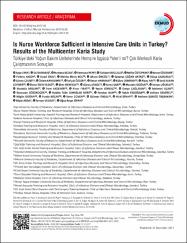| dc.contributor.author | Uyan, Ayşe | |
| dc.contributor.author | Durmuş, Gül | |
| dc.contributor.author | Sezak, Nurbanu | |
| dc.contributor.author | Pepe, Fatmanur | |
| dc.contributor.author | Kaygusuz, Türkkan | |
| dc.contributor.author | Öztoprak, Nefise | |
| dc.contributor.author | Özdemir, Kevser | |
| dc.contributor.author | Aksoy, Firdevs | |
| dc.contributor.author | Erol, Serpil | |
| dc.contributor.author | Koç, Meliha Meriç | |
| dc.contributor.author | Öncül, Ahsen | |
| dc.contributor.author | Çağan Aktaş, Sabahat | |
| dc.contributor.author | Çaşkurlu, Hülya | |
| dc.contributor.author | Çelebi, Güven | |
| dc.contributor.author | Kandemir, Özlem | |
| dc.contributor.author | Özger, Selçuk | |
| dc.contributor.author | Harman, Rezan | |
| dc.contributor.author | Demiray, Kübra | |
| dc.contributor.author | Arı, Alpay | |
| dc.contributor.author | Alkan Çeviker, Sevil | |
| dc.contributor.author | Yıldız, İlknur Esen | |
| dc.contributor.author | Menekşe, Şirin | |
| dc.contributor.author | Şenol, Güneş | |
| dc.contributor.author | Sarı, Sema | |
| dc.contributor.author | Doğan, Mustafa | |
| dc.contributor.author | Uğurlu, Kenan | |
| dc.contributor.author | Arslan, Mustafa | |
| dc.contributor.author | Akdemir, İrem | |
| dc.contributor.author | Fırat, Pınar | |
| dc.contributor.author | Kürekçi, Yeşim | |
| dc.contributor.author | Çağlayan, Derya | |
| dc.contributor.author | Uçar, Mehmet | |
| dc.contributor.author | Gözüküçük, Ramazan | |
| dc.contributor.author | Elmaslar Mert, Habibe Tülin | |
| dc.contributor.author | Alay, Handan | |
| dc.contributor.author | Erdoğan, Haluk | |
| dc.contributor.author | Demirel, Aslıhan | |
| dc.contributor.author | Doğan, Nilgün | |
| dc.contributor.author | Koçak, Funda | |
| dc.contributor.author | Güven, Emre | |
| dc.contributor.author | Ünsal, Güleser | |
| dc.contributor.author | Sipahi, Hilal | |
| dc.contributor.author | Işıkgöz, Taşbakan | |
| dc.contributor.author | Arda, Bilgin | |
| dc.contributor.author | Ulusoy, Sercan | |
| dc.contributor.author | Sipahi, Oğuz Reşat | |
| dc.date.accessioned | 2020-12-19T19:49:03Z | |
| dc.date.available | 2020-12-19T19:49:03Z | |
| dc.date.issued | 2017 | |
| dc.identifier.citation | Uyan, A., Durmuş, g., Sezak, N., Pepe, F., Kayusuz, T.,... & Sipahi, O.R. (2017). Is Nurse Workforce Sufficient in Intensive Care Units in Turkey?
Results of the Multicenter Karia Study. Mediterranean Journal of Infection Microbes and Antimicrobials, 6, 20. https://doi.org/10.4274/mjima.2017.20 | en_US |
| dc.identifier.issn | 2147-673X | |
| dc.identifier.uri | https://doi.org/10.4274/mjima.2017.20 | |
| dc.identifier.uri | https://hdl.handle.net/11436/2211 | |
| dc.description | Kaygusuz, Irfan/0000-0002-5237-2362; | en_US |
| dc.description | WOS: 000436268000001 | en_US |
| dc.description.abstract | Introduction: in this multicenter study, we analysed the magnitude of healthcare worker (HCW) [infection control practitioner (ICP), nurses and others] workforce in hospitals participated in the study. Materials and Methods: This study was performed in 41 hospitals (with intensive care units-ICU) located in 22 cities from seven regions of Turkey. We analysed the ICP workforce, nursing and auxiliary HCW (AHCW) workforce in ICUs, number of ICU beds and occupied beds in four different days [two of which were in summer during the vacation time (August 27 and 31, 2016) and two others in autumn (October 12 and 15, 2016)]. the Turkish Ministry of Health (TMOH) requires two patients per nurse in level 3 ICUs, three patients per nurse in level 2 ICUs and five patients per nurse in level 1 ICUs. There is no standardization for the number of AHCW in ICUs. Finally, one ICP per 150 hospital beds is required by TMOH. Results: the total number of ICUs, ICU beds and ICPs were 214, 2377 and 111, respectively in he 41 participated centers. the number ICPs was adequate only in 12 hospitals. the percentage of nurses whose working experience was <1 year, was; 19% in level 1 ICUs, 25% in level 2 ICUs and 24% in level 3 ICUs. the number of patients per nurse was mostly <5 in level 1 ICUs whereas the number of patients per nurse in level 3 ICUs was generally >2. the number of patients per other HCW was minimum 3.75 and maximum 4.89 on weekdays and on day shift while it was minimum 5.02 and maximum 7.7 on weekends or on night shift. When we compared the number of level 1, 2 and 3 ICUs with adequate nursing workforce vs inadequate nursing workforce, the p value was <0.0001 at all time points except summer weekend night shift (p=0.002). Conclusion: Our data suggest that ICP workforce is inadequate in Turkey. Besides, HCW workforce is inadequate and almost 1/4 of nurses are relatively inexperienced especially in level 3 ICUs. Turkish healthcare system should promptly make necessary arrangements for adequate HCW staffing. | en_US |
| dc.language.iso | eng | en_US |
| dc.publisher | Galenos Yayincilik | en_US |
| dc.rights | info:eu-repo/semantics/openAccess | en_US |
| dc.subject | Infection control | en_US |
| dc.subject | Infection | en_US |
| dc.subject | Healthcare-associated infections | en_US |
| dc.subject | Intensive care infections | en_US |
| dc.subject | Infection control practitioner | en_US |
| dc.title | Is nurse workforce sufficient in ıntensive care units in Turkey. Results of the multicenter karia study | en_US |
| dc.title.alternative | Türkiye’deki yoğun bakım ünitelerinde hemşire işgücü yeterli mi? Çok merkezli karia çalışmasının sonuçları | en_US |
| dc.type | article | en_US |
| dc.contributor.department | RTEÜ, Tıp Fakültesi, Dahili Tıp Bilimleri Bölümü | en_US |
| dc.contributor.institutionauthor | Yıldız, İlknur Esen | |
| dc.identifier.doi | 10.4274/mjima.2017.20 | |
| dc.identifier.volume | 6 | en_US |
| dc.ri.edit | oa | en_US |
| dc.relation.journal | Mediterranean Journal of Infection Microbes and Antimicrobials | en_US |
| dc.relation.publicationcategory | Makale - Uluslararası Hakemli Dergi - Kurum Öğretim Elemanı | en_US |


















